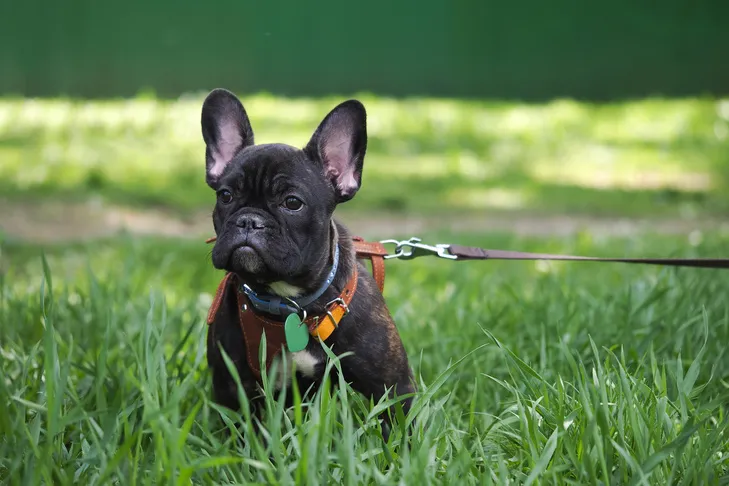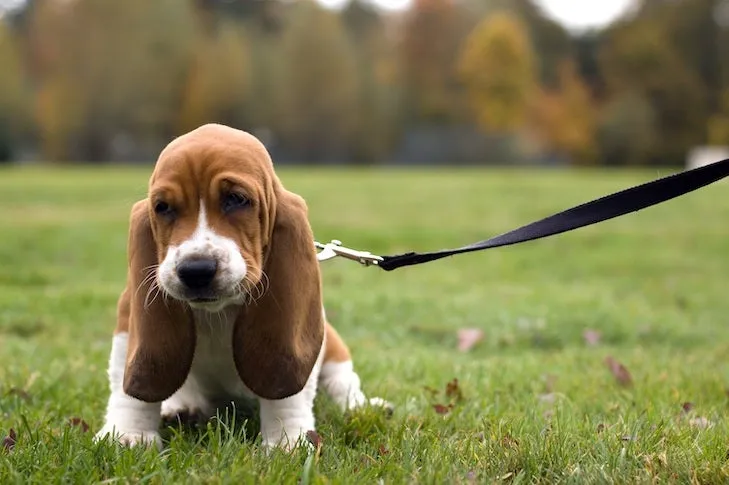Many new puppy parents wonder when they should start walking their furry friend on a leash, assuming it’s an innate skill. However, polite leash walking is a crucial skill that needs to be taught and practiced. Mastering it will make every outing with your dog more enjoyable and safer. Dog training expert and AKC Family Dog training and behavior columnist Kathy Santo emphasizes the importance of early and consistent training to build a strong foundation. This guide will help you understand the ideal time to begin and the steps to ensure successful leash training for your puppy.
Generally, you can start introducing your puppy to a collar and leash as early as 8 weeks old, focusing on positive associations and short, fun sessions indoors. The actual outdoor walks on a leash should begin once your puppy has completed their initial series of vaccinations, usually around 12-16 weeks of age, and has developed some basic obedience skills. This ensures their safety and reduces exposure to potential illnesses. A well-trained puppy will confidently walk by your side, transforming walks into a pleasant experience for both of you. how to train your puppy to walk is a great next step after these foundational lessons.
Building the Foundation for Leash Walking
Establishing a solid groundwork is essential for any future walks with your dog. Follow these steps to prepare your puppy for leash success.
Introduce the Collar or Harness and Leash
Begin by familiarizing your puppy with wearing a collar or a harness and a leash. Let them wear these items for very short periods while playing or giving treats inside the house. The goal is for your puppy to associate their collar and leash with positive experiences, such as food and fun. This positive reinforcement helps prevent resistance later on.
Teach an Attention Cue
Introduce a consistent sound cue that signifies “food is coming.” This could be a clicker, a specific word like “yes,” or a tongue cluck. In a quiet, distraction-free environment, with your puppy wearing their collar and leash, make the sound. The moment your puppy looks at or turns towards you, immediately reward them with a treat. After several repetitions, your puppy will not only look at you but also begin to move towards you for the treat, understanding that the sound means a reward is imminent.
 French bulldog puppy in a harness sitting in tall green grass on a leash for a walk.
French bulldog puppy in a harness sitting in tall green grass on a leash for a walk.
Encourage Your Puppy to Come to You
While your puppy is en route to you, still wearing their leash and collar, take a few steps backward. Reward them enthusiastically when they reach you. Gradually, continue this progression until your puppy, upon hearing the cue, comes to you and walks alongside you for a few paces. Remember that puppies have short attention spans. Keep your training sessions brief and engaging, always ending them while your puppy is still eager for more, rather than when they become mentally exhausted.
Practice Leash Walking Indoors
Once your puppy understands how to reliably come to you, practice walking a few steps in a room with minimal distractions. Simply feeling and seeing the leash around them will be enough of a challenge at this stage. Offer plenty of treats and praise as your puppy learns to follow you while on a leash. This controlled environment builds confidence before facing the outside world.
Transitioning to Outdoor Walks
Finally, when your puppy is fully vaccinated and comfortable with indoor leash work, you’re ready to test their skills outdoors. This step introduces new challenges, as all the sounds, smells, and sights will be new and exciting. Be patient and keep initial outdoor walks short. If you notice your puppy is about to lunge or become distracted, use your attention cue and move a few steps away. Reward them with a treat for following you and redirecting their focus. Ensuring your puppy is also learning how to train a husky puppy to pee outside can make outdoor trips more productive.
 Basset Hound puppy sitting in the grass on lead.
Basset Hound puppy sitting in the grass on lead.
Troubleshooting Common Leash-Training Issues
Even with excellent foundational training, you might encounter some common issues as your puppy grows, explores new places, and faces new distractions. Teaching them how to train dog to walk off lead is a more advanced goal, but addressing basic leash problems first is key. Loose-leash walking is more enjoyable for both of you and is a prerequisite for certifications like the Canine Good Citizen test. Here are some tips from the AKC GoodDog! Helpline for common leash-training challenges.
If Your Puppy Pulls
Should your dog begin to pull in the opposite direction, immediately stop and become “a tree.” Stand completely still and refuse to move until your dog relaxes the leash and returns to you. Avoid yanking or jerking the leash, or dragging your dog along. Training tools such as front-hook harnesses and head halters can also be effective alternatives for dogs prone to pulling, helping to redirect their attention and make walks more manageable.
If Your Puppy Lunges
If your dog starts lunging at something during a walk—another dog, a car, or a skateboarder, for instance—it’s crucial to be proactive. Try to redirect their attention with a treat before they have a chance to lunge. Increase the distance between your dog and the object of their fixation. Stay vigilant and be prepared to intervene before the potential trigger gets too close. This behavior can be more prevalent in certain breeds like herding dogs, but any dog can be startled or overstimulated by unfamiliar or exciting elements in their environment.
If Your Puppy Barks
Some dogs develop a habit of barking excessively at other dogs during walks. Often, this behavior can stem from a lack of adequate physical and mental stimulation. Ensure your dog receives the proper amount of exercise and enrichment for their age and breed. If barking persists, apply a similar strategy as you would for lunging: create distance and offer treats before they start to bark. With consistent practice, your puppy will learn to associate seeing other dogs with turning their attention back to you for a reward. For other barking issues, consider resources on how to stop your dog barking at night.
Conclusion
Starting leash training early and consistently is paramount to developing a well-behaved walking companion. By introducing the collar and leash positively, teaching an attention cue, practicing indoors, and gradually moving to outdoor environments, you’re setting your puppy up for success. Addressing common issues like pulling, lunging, and barking with patience and positive reinforcement will strengthen your bond and make every walk a joy. Remember to always keep treats on hand to randomly reinforce good leash-walking behavior. While training can be challenging, the rewards of a well-behaved dog are immeasurable.
